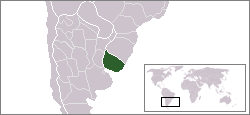
Back Uruguay ACE Uruguay Afrikaans Uruguay ALS ኡሩጓይ Amharic Uruguay AMI Uruguai AN Uruquaria ANG Yurugwai ANN उरुग्वे ANP الأوروغواي Arabic
Oriental Republic of Uruguay
| |
|---|---|
| Motto: "Libertad o Muerte" (Spanish) "Freedom or Death" | |
| Anthem: Himno Nacional de Uruguay National Anthem of Uruguay | |
 | |
| Capital and largest city | Montevideo |
| Official language |
|
| Ethnic groups ([1]) |
|
| Demonym(s) | Uruguayan |
| Government | Unitary presidential constitutional republic |
| Luis Alberto Lacalle Pou | |
| Beatriz Argimón | |
| Legislature | General Assembly |
| Chamber of Senators | |
| Chamber of Deputies | |
| Independence from the Empire of Brazil | |
• Declaration | 25 August 1825 |
| 28 August 1828 | |
• Constitution | 18 July 1830 |
| Area | |
• Total | 176,215 km2 (68,037 sq mi) (91st) |
• Water (%) | 1.5 |
| Population | |
• 2011 estimate | 3,318,535[1] (133rd) |
• 2011 census | 3,286,314[2] |
• Density | 18.65/km2 (48.3/sq mi) (196th) |
| GDP (PPP) | 2013 estimate |
• Total | $56.338 billion[3] |
• Per capita | $16,607[3] |
| GDP (nominal) | 2013 estimate |
• Total | $55.412 billion[3] |
• Per capita | $16,334[3] |
| Gini (2010) | 45.3[4] medium |
| HDI (2013) | high · 51st |
| Currency | Uruguayan peso (UYU) |
| Time zone | UTC−3 (UYT) |
• Summer (DST) | UTC−2 (UYST) |
| Driving side | right |
| Calling code | +598 |
| ISO 3166 code | UY |
| Internet TLD | .uy |
Preview warning: Page using Template:Infobox country with unknown parameter "longm"
Preview warning: Page using Template:Infobox country with unknown parameter "longEW"
Preview warning: Page using Template:Infobox country with unknown parameter "longd"
Preview warning: Page using Template:Infobox country with unknown parameter "latm"
Preview warning: Page using Template:Infobox country with unknown parameter "latNS"
Preview warning: Page using Template:Infobox country with unknown parameter "latd"

Uruguay (officially named Oriental Republic of Uruguay) is a country in South America. The language spoken there is Spanish. Its capital and largest city is Montevideo. Uruguay is bordered by two large neighbors, Brazil and Argentina. The only country in South America that is smaller than Uruguay is Suriname. The land is mostly flat, and there are many farms in the countryside.
The area around Uruguay was fought over by the Portuguese and Spanish Empires in the 18th century. In the 1810s it was the center of the Banda Oriental, a Federal League of states in the Río de la Plata region. Argentina and Brazil took the majority in wars, leaving Uruguay as independent.
- ↑ 1.0 1.1 Cite error: The named reference
ciawas used but no text was provided for refs named (see the help page). - ↑ Resultados del Censo de Población 2011: población, crecimiento y estructura por sexo y edad Archived 2014-02-09 at the Wayback Machine ine.gub.uy
- ↑ 3.0 3.1 3.2 3.3 "Uruguay". International Monetary Fund. Retrieved 4 January 2012.
- ↑ "Gini Index". World Bank. Retrieved 14 April 2012.
- ↑ "Human Development Report 2013" (PDF). United Nations Development Programme. 14 March 2013. Archived from the original (PDF) on 8 July 2014. Retrieved 14 March 2013.

